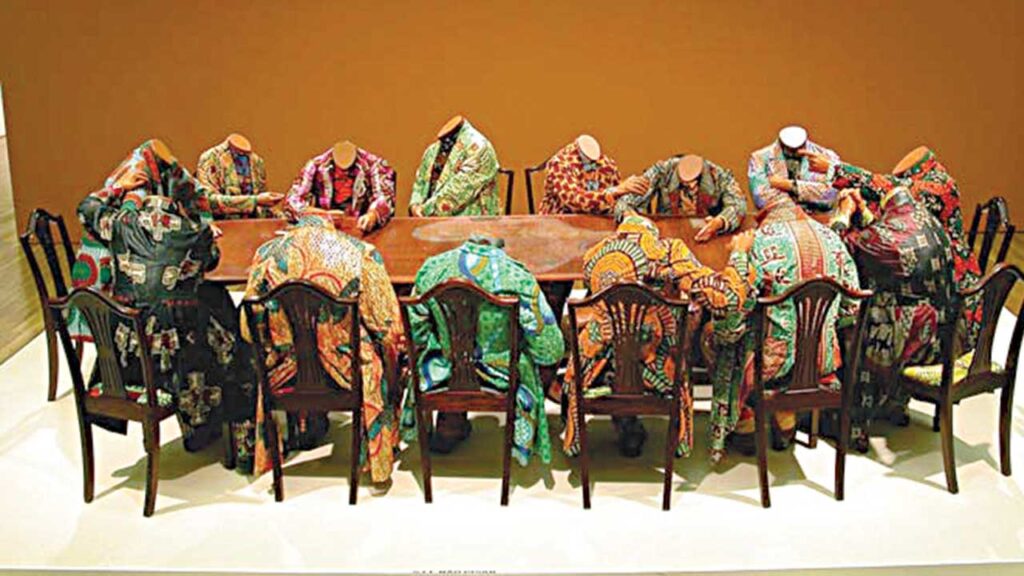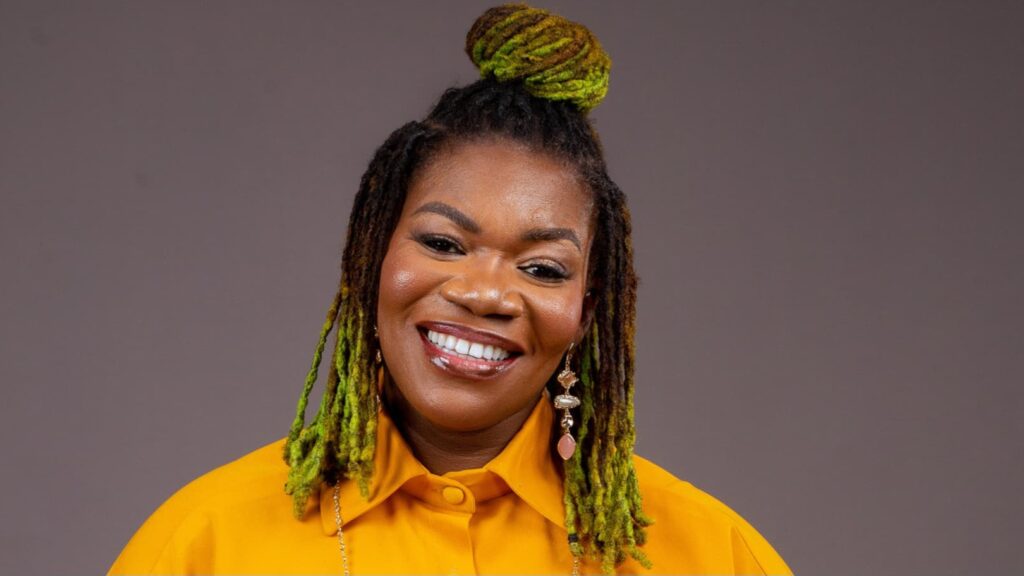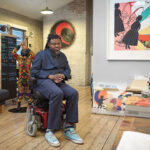
Never mind that he adds British-Nigerian artist to his name; Yinka Shonibare is every inch a Nigerian. He equally enjoys discussing the thriving African art. Recently, the artist launched Guest Artists Space (G.A.S.) Foundation cultural centre in Nigeria.
G.A.S. is a non-profit dedicated to facilitating cultural exchange through tailored residencies, public programmes and exhibition opportunities primarily for creative practitioners from Africa and the diaspora.
It is also dedicated to facilitating skills development, by supporting and enabling creative and research practices through residencies, collaborations, fellowships, education and professional development.
In response to the global COVID-19 crisis, Guest Projects moved away from physical residencies, focusing instead on digitally enabling and supporting the creation of new works, testing of ideas, mentoring, creative programming and online community engagement.
The COVID-19 pandemic and subsequent lockdown was an initial challenge, “and we couldn’t open the centre,” Shonibare says.
The GAS cultural centre in Oniru, Lagos was designed by Ghanaian-British architect, Elsie Owusu, in collaboration with a Lagos-based NS Design Consult.
The building houses a multifunctional studio/ gallery space on the ground floor with accommodation and shared living space on the first floor for up to three artists-in-residence with a ‘barrier-free’ design to ensure access for all users.
At the second centre, based in Ijebu, he has completed work on one of his most ambitious projects yet, the Ecology Green Farm.
It provides a residency space for artists, scientists, agriculturists, and researchers and was created with sustainable infrastructure and food security for the local community in mind.
Working in partnership with architect Papa Omotayo, they’ve established an organic farm across a 54-acre site whilst overseeing a team of local artisans hand making 40,000 bricks to construct a state-of-the-art artists residence and workshop.
The artist, who is excited about his new project, says, “the art world needs to evolve – there is a rich vein of talent out there, but we might lose them if the status quo of the last 30 years remains. We are working with the local community, whilst opening doors for the next generation, equipping them to thrive not just survive.”
Through these projects, he reflects his ongoing beliefs in the relationship between art and social justice showing how the combined disciplines of architecture and science can contribute to local ecosystems, food security and of course, creativity.
“I am hoping that the project will help to support their careers, educate people who will do research because it about career development, education, learning from other artist, and giving people time to develop their work so that they never think of paying rent or having a second talk,” he says.
The charity’s ambition is to encourage critical and engaging practices in the fields of contemporary art, design, architecture, agriculture and ecology with the space to research, experiment, share, educate and develop ideas.
Shonibare is not completely relocating home, he says, “as an international artist, you live in different places but at some point, I might do that.”
FOR the artist, who is making waves, because of his experimentation with form, “there is a lot of interest in African art in the west at the moment.”
The 2021 edition of his GAS project platformed the work of six emerging African and African Diaspora artists, based across both the UK and the continent, through a series of Artist in Focus and Digital Residency awards.
Over the past decade, he has tirelessly supported the development of early career and African diaspora artists.
The six participants received a fee, professional development opportunities and tailored mentoring alongside an opportunity to showcase their work on the Guest Projects Digital website and social channels.
The UK based artist residency programme offered emerging multidisciplinary creatives and practitioners free access to a project space in which to collaborate and experiment for one month.

As a British artist, he is hoping that he will have the same connection with Nigeria artists as he has had in his international sojourn.
Though he doesn’t belong to the Society of Nigerian Artists (SNA), he reveals, “ I am hoping that I would have connection better with Nigerian artists because we are going to have events here where artists can come and listen to talks, hear other artist speak and look at their works.”
How do you stay connected up to date with the art world?
“I look at magazines, social media and the way it is normally done back then,” he laughs.
On how useful social media has been to his career, he has this to say. “My career was already getting up before social media. My galleries and other people work with me, do, some production on social media. I can see that it is a good way for many people to have access to art and to see all the artist work, but I don’t think it has made a significant impact.”
BORN August 9, 1962, he was three years old, his family moved to Lagos, Nigeria, where his father practised law. When he was 17 years old, Shonibare returned to Britain to do his A-levels at Redrice School. At the age of 18, he contracted transverse myelitis, an inflammation of the spinal cord, which resulted in a long-term physical disability where one side of his body is paralysed.
Shonibare went on to study Fine Art first at Byam Shaw School of Art (now Central Saint Martins College of Art and Design) and then at Goldsmiths, University of London, where he received his MFA degree, graduating as part of the Young British Artists generation. Following his studies, Shonibare worked as an arts development officer for Shape Arts, an organisation that makes arts accessible to people with disabilities.
His work explores cultural identity, colonialism and post-colonialism within the contemporary context of globalisation. A hallmark of his art is the brightly coloured Ankara fabric he uses.
As a child living in Lagos, Nigeria, Shonibare first saw Nigerian artist Twins Seven Seven on television. Shonibare recalls himself being a rebel and feeling a strong connection to this artist.
At the time, Twins Seven Seven wore his hair relatively long, in individual braids and was immersed in a trans disciplinary creative practice, working simultaneously as a visual artist and a performance artist.
Despite their remote association, the now late artist was a role model for Shonibare who would become a visual artist working across multiple media with curiosity and candour.
This development had much to do with Shonibare’s relocation to London in the 1980s to study visual art. While there, artists such as Rotimi Fani-Kayode inspired a young Shonibare, who was keen to connect with other Nigerian artists working in London during the 1980s and 90s. Fani-Kayode and Shonibare were to have met; sadly, Fani-Kayode passed away unexpectedly before the scheduled meeting date.
Some years later, Shonibare saw Bruce Onobrakpeya’s works at Whitechapel in 1995, as part of the acclaimed exhibition, Seven Stories about Africa.
And in 2000, Onobrakpeya attended Shonibare’s exhibition at Camden Arts Centre, which was where the two artists first met. The two artists have since connected in Lagos on multiple occasions.
Did he encounter art enough to become an artist?
“Yes, I saw a lot of works. So, those artists inspired me,” he smiles
“Before I went to Europe, my dad sent me to have a talk with the late Yusuf Grillo. I told him about my decision to study art in London and he shared some of his works and I was inspired to follow his footsteps. After our discussion, I was encouraged,” Shonibare, says.
He continues, “I left Nigeria and when I came back a few years later, I realised that a lot of the country’s artists didn’t have as much opportunity, as I did in UK. I thought that I should help and support some of these local artists.”
A master of technical and visual versatility, he is respected for his embrace of richly patterned Dutch wax textiles, which are applied to the surface of canvases and three-dimensional landscapes.
SINCE 1994, this brightly coloured ‘African’ fabric (Dutch wax-printed cotton), which he buys himself from Brixton market in London, has been one of his most used media of communication, especially for his installation art. Though the fabrics are actually not authentically African the way people think; it has deconstructed his perception of culture. To him, “it’s an artificial construct.”
His words: “I started using Dutch wax in my art as a way of expressing the dual identity of a modern African like myself, to understand that the identity of a post-colonial African has been touched by Africa’s contact with the rest of the world.” Working across painting, sculpture, photography, film and installation, Shonibare’s work examines race, class and the construction of cultural identity within the contemporary context of globalisation.
“I explore a number of themes in my works, subjects can be as varied as colonialism, climate change, history, literature, philosophy, semiotics, science, Art history, eugenics, sexuality, materiality, public art, curating, social interventions and production,” he says.
Though, creating such great and timeless pieces requires a lot of time, hardwork and energy, Shonibare believes the structure in his office provides opportunity for a flow of ideas.
“My studio in London operates like an architect’s office, I work with a large team of people. We start with a subject matter, and then, we do further research, then I create a proposal followed by a design meeting with fabricators. I also do a lot of designs for my woodcuts and screen prints. The team consists of costume makers, Quilt makers, engineers, administrative staff, sculptors, photographers, painters, print makers, solicitors and commercial galleries,” he says.
KNOWN for using batik in costumed dioramas that explore race and colonialism, he also employs painting, sculpture, photography, and film in work that disrupts and challenges our notions of cultural identity.
Taking on the honourific CBE (and previously MBE) as part of his name in everyday use, Shonibare plays with the ambiguities and contradictions of his attitude toward the establishment and its legacies of colonialism and class.
In multimedia projects that reveal his passion for art history, literature, and philosophy, Shonibare provides a critical tour of Western civilisation and its achievements and failures.
At the same time, his sensitive use of his own foibles (vanity, for one) and challenges (physical disability) provide an autobiographical perspective through which to navigate the contradictory emotions and paradoxes of his examination of individual and political power.












